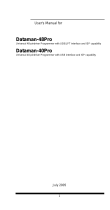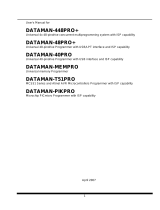36 DataMan 60 Quick Reference Guide DataMan 60 Quick Reference Guide 37
Conguring for Multi-Port Operation
You must connect the Setup Tool to each DataMan 60 in turn and enable multi-
port operation. Click the Communication Settings task and check the Enable
Multi-Port (RS-232 Sharing) check box.
There is no guaranteed delivery order when multiple readers transmit data
using a multi-port connection; read results may arrive at the PC in any order.
You can congure each DataMan 60 reader in a multi-port connection to add
identifying data to each read result. Your PC application can then determine
which reader produced a specic read result.
To do this, click on the Data Formatting task, click the appropriate Standard
box (for each symbology that you are using), go to the Standard Formatting
pane, and enter text in the Leading Text eld. (You can also add trailing text
by entering text in the Terminating Text eld.)
You can obtain the best results when using multi-port connections by
keeping the following usage guidelines in mind as you design your
system:
• The maximum cable length between any two DataMan readers or
between the PC and any DataMan reader should be no greater than
15 meters.
• There is no xed limit to the number of DataMan readers that you
can connect to a single PC. Each reader introduces a delay of about
100 msec when it retransmits received serial data. If you have 5
readers, this means that there will be a 400 msec delay between the
time the rst reader in the chain transmits data and the PC receives
it.
• Each DataMan reader must receive a hardware trigger signal on its
Input 0 line. You can wire the input ports to a common trigger signal
or you can provide individual triggers for each reader.
• If any reader in the multi-port chain loses power or becomes
disconnected, then no data from any other reader will be
transmitted.
• If a DataMan is transmitting its own read result, it will buffer any
data received from another reader until it has nished its own data
transmission. If a DataMan reader is transmitting another reader’s
data, it will buffer its own data if it receives a trigger signal while it is
processing the other reader’s data.
• If you use a single power supply for multiple readers, make sure that
the power supply can provide enough power for all of the readers.
• You cannot connect a reader to the Setup Tool over RS-232 once
multiport is enabled. You must rst scan the Disable Multi-Port code
from the Reader Conguration Codes, available from the Start
menu.
Multi-Port Usage Notes





















